SWM532 - Budgeting in Healthcare: Activity Based Funding Model
VerifiedAdded on 2023/06/13
|15
|4293
|295
Report
AI Summary
This report examines the role of budgeting in healthcare organizations, particularly within an Activity Based Funding (ABF) environment. It discusses the advantages and disadvantages of ABF, highlighting its impact on cost management, resource allocation, and service quality. The report also addresses the complexities of healthcare budgeting, including the challenges of forecasting financial needs and the potential for inaccurate assumptions. Furthermore, the report explores various budgeting models, such as top-down, bottom-up, incremental, zero-based, base, and activity-based budgeting, assessing their suitability for the healthcare industry. It emphasizes the importance of accurate financial planning for effective decision-making and resource utilization in healthcare settings. Desklib provides access to similar solved assignments and study tools for students.
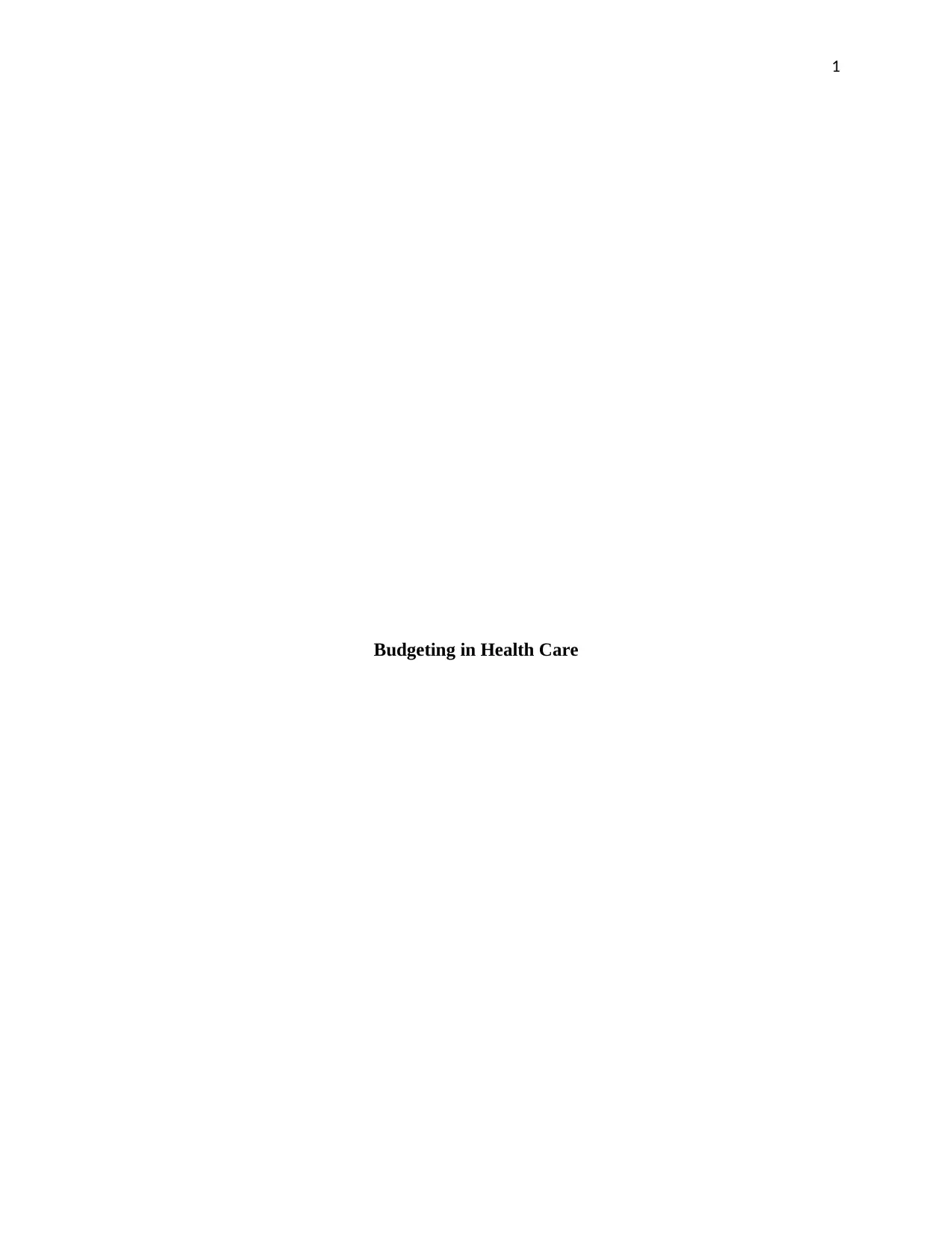
1
Budgeting in Health Care
Budgeting in Health Care
Paraphrase This Document
Need a fresh take? Get an instant paraphrase of this document with our AI Paraphraser
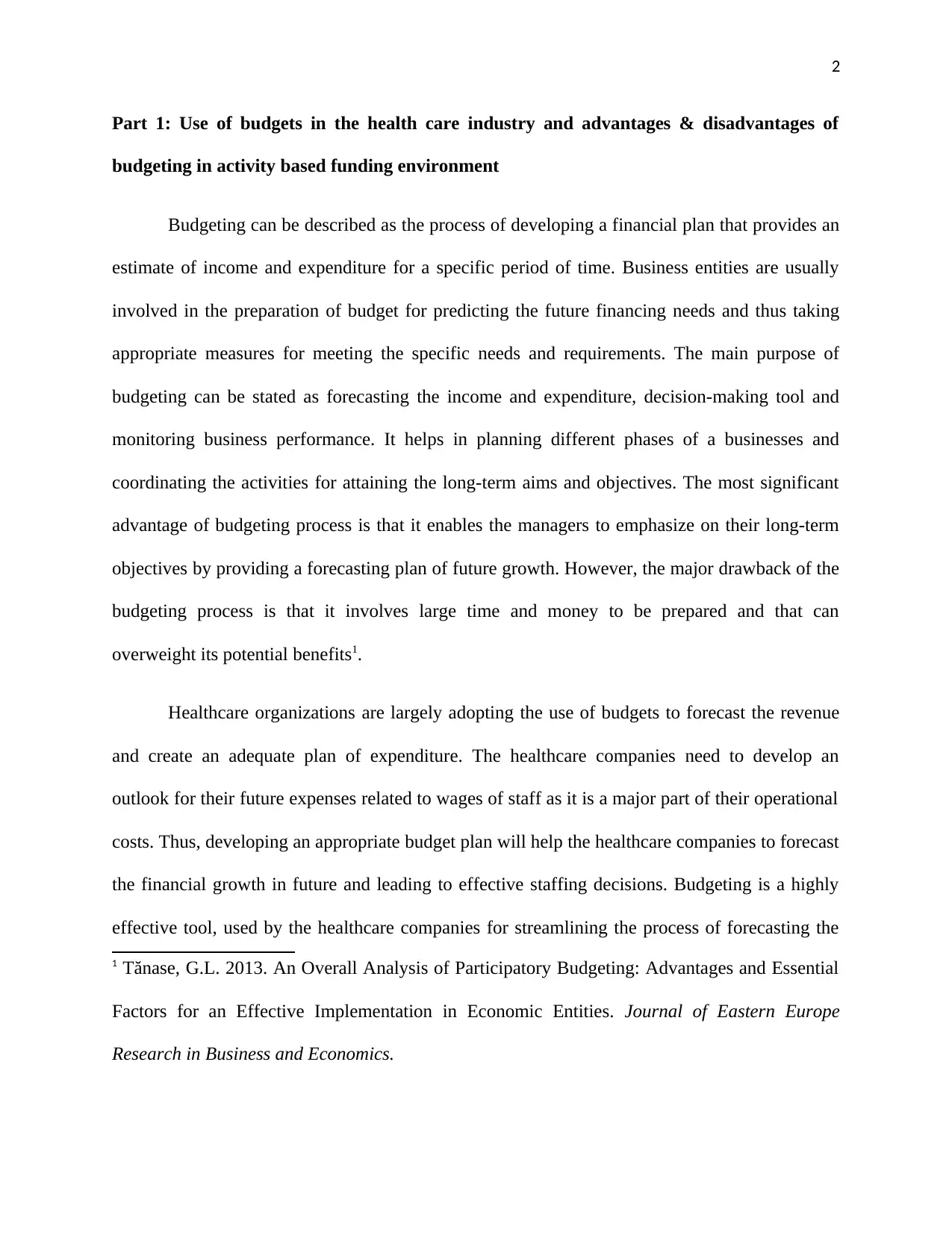
2
Part 1: Use of budgets in the health care industry and advantages & disadvantages of
budgeting in activity based funding environment
Budgeting can be described as the process of developing a financial plan that provides an
estimate of income and expenditure for a specific period of time. Business entities are usually
involved in the preparation of budget for predicting the future financing needs and thus taking
appropriate measures for meeting the specific needs and requirements. The main purpose of
budgeting can be stated as forecasting the income and expenditure, decision-making tool and
monitoring business performance. It helps in planning different phases of a businesses and
coordinating the activities for attaining the long-term aims and objectives. The most significant
advantage of budgeting process is that it enables the managers to emphasize on their long-term
objectives by providing a forecasting plan of future growth. However, the major drawback of the
budgeting process is that it involves large time and money to be prepared and that can
overweight its potential benefits1.
Healthcare organizations are largely adopting the use of budgets to forecast the revenue
and create an adequate plan of expenditure. The healthcare companies need to develop an
outlook for their future expenses related to wages of staff as it is a major part of their operational
costs. Thus, developing an appropriate budget plan will help the healthcare companies to forecast
the financial growth in future and leading to effective staffing decisions. Budgeting is a highly
effective tool, used by the healthcare companies for streamlining the process of forecasting the
1 Tănase, G.L. 2013. An Overall Analysis of Participatory Budgeting: Advantages and Essential
Factors for an Effective Implementation in Economic Entities. Journal of Eastern Europe
Research in Business and Economics.
Part 1: Use of budgets in the health care industry and advantages & disadvantages of
budgeting in activity based funding environment
Budgeting can be described as the process of developing a financial plan that provides an
estimate of income and expenditure for a specific period of time. Business entities are usually
involved in the preparation of budget for predicting the future financing needs and thus taking
appropriate measures for meeting the specific needs and requirements. The main purpose of
budgeting can be stated as forecasting the income and expenditure, decision-making tool and
monitoring business performance. It helps in planning different phases of a businesses and
coordinating the activities for attaining the long-term aims and objectives. The most significant
advantage of budgeting process is that it enables the managers to emphasize on their long-term
objectives by providing a forecasting plan of future growth. However, the major drawback of the
budgeting process is that it involves large time and money to be prepared and that can
overweight its potential benefits1.
Healthcare organizations are largely adopting the use of budgets to forecast the revenue
and create an adequate plan of expenditure. The healthcare companies need to develop an
outlook for their future expenses related to wages of staff as it is a major part of their operational
costs. Thus, developing an appropriate budget plan will help the healthcare companies to forecast
the financial growth in future and leading to effective staffing decisions. Budgeting is a highly
effective tool, used by the healthcare companies for streamlining the process of forecasting the
1 Tănase, G.L. 2013. An Overall Analysis of Participatory Budgeting: Advantages and Essential
Factors for an Effective Implementation in Economic Entities. Journal of Eastern Europe
Research in Business and Economics.
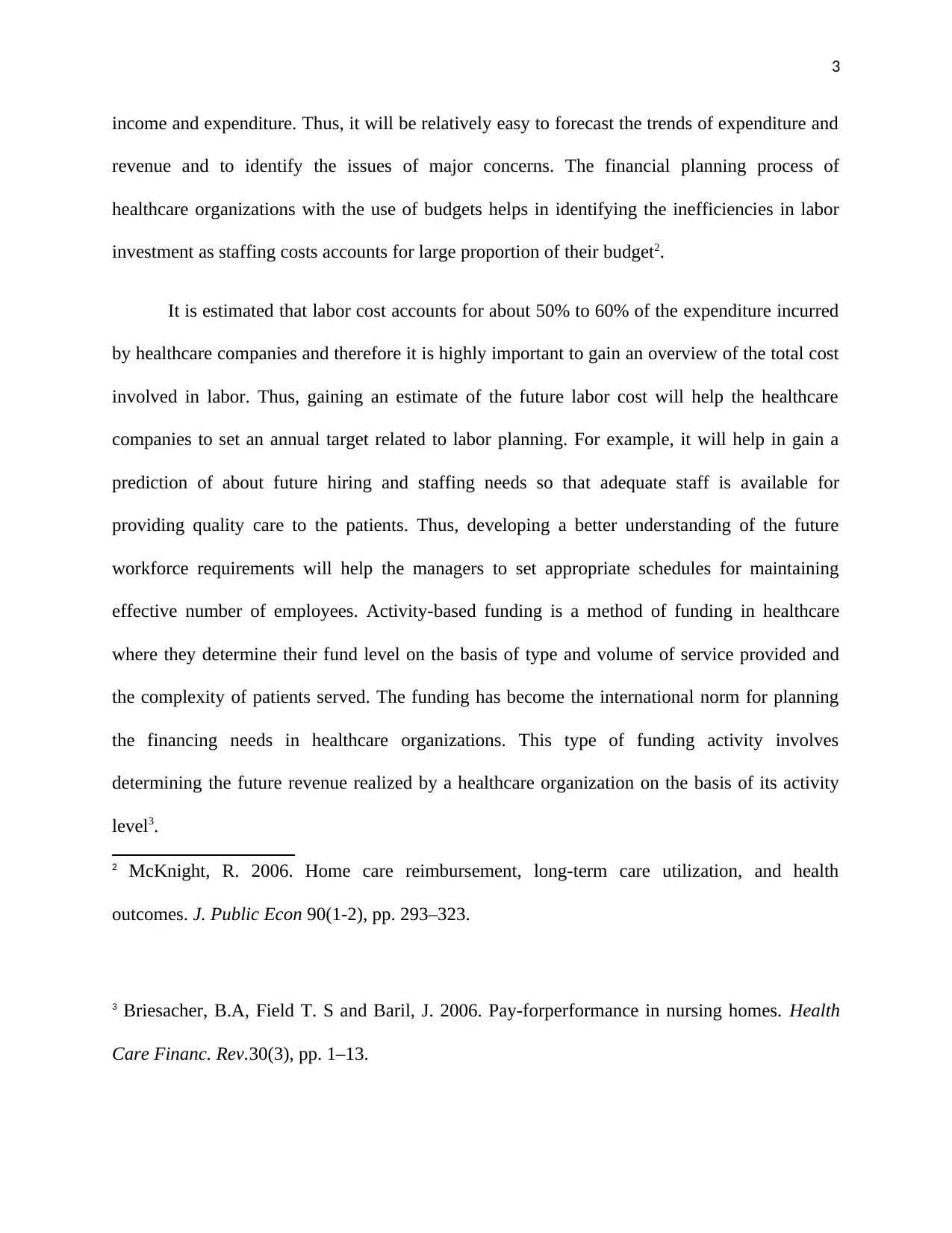
3
income and expenditure. Thus, it will be relatively easy to forecast the trends of expenditure and
revenue and to identify the issues of major concerns. The financial planning process of
healthcare organizations with the use of budgets helps in identifying the inefficiencies in labor
investment as staffing costs accounts for large proportion of their budget2.
It is estimated that labor cost accounts for about 50% to 60% of the expenditure incurred
by healthcare companies and therefore it is highly important to gain an overview of the total cost
involved in labor. Thus, gaining an estimate of the future labor cost will help the healthcare
companies to set an annual target related to labor planning. For example, it will help in gain a
prediction of about future hiring and staffing needs so that adequate staff is available for
providing quality care to the patients. Thus, developing a better understanding of the future
workforce requirements will help the managers to set appropriate schedules for maintaining
effective number of employees. Activity-based funding is a method of funding in healthcare
where they determine their fund level on the basis of type and volume of service provided and
the complexity of patients served. The funding has become the international norm for planning
the financing needs in healthcare organizations. This type of funding activity involves
determining the future revenue realized by a healthcare organization on the basis of its activity
level3.
2 McKnight, R. 2006. Home care reimbursement, long-term care utilization, and health
outcomes. J. Public Econ 90(1-2), pp. 293–323.
3 Briesacher, B.A, Field T. S and Baril, J. 2006. Pay-forperformance in nursing homes. Health
Care Financ. Rev.30(3), pp. 1–13.
income and expenditure. Thus, it will be relatively easy to forecast the trends of expenditure and
revenue and to identify the issues of major concerns. The financial planning process of
healthcare organizations with the use of budgets helps in identifying the inefficiencies in labor
investment as staffing costs accounts for large proportion of their budget2.
It is estimated that labor cost accounts for about 50% to 60% of the expenditure incurred
by healthcare companies and therefore it is highly important to gain an overview of the total cost
involved in labor. Thus, gaining an estimate of the future labor cost will help the healthcare
companies to set an annual target related to labor planning. For example, it will help in gain a
prediction of about future hiring and staffing needs so that adequate staff is available for
providing quality care to the patients. Thus, developing a better understanding of the future
workforce requirements will help the managers to set appropriate schedules for maintaining
effective number of employees. Activity-based funding is a method of funding in healthcare
where they determine their fund level on the basis of type and volume of service provided and
the complexity of patients served. The funding has become the international norm for planning
the financing needs in healthcare organizations. This type of funding activity involves
determining the future revenue realized by a healthcare organization on the basis of its activity
level3.
2 McKnight, R. 2006. Home care reimbursement, long-term care utilization, and health
outcomes. J. Public Econ 90(1-2), pp. 293–323.
3 Briesacher, B.A, Field T. S and Baril, J. 2006. Pay-forperformance in nursing homes. Health
Care Financ. Rev.30(3), pp. 1–13.
⊘ This is a preview!⊘
Do you want full access?
Subscribe today to unlock all pages.

Trusted by 1+ million students worldwide
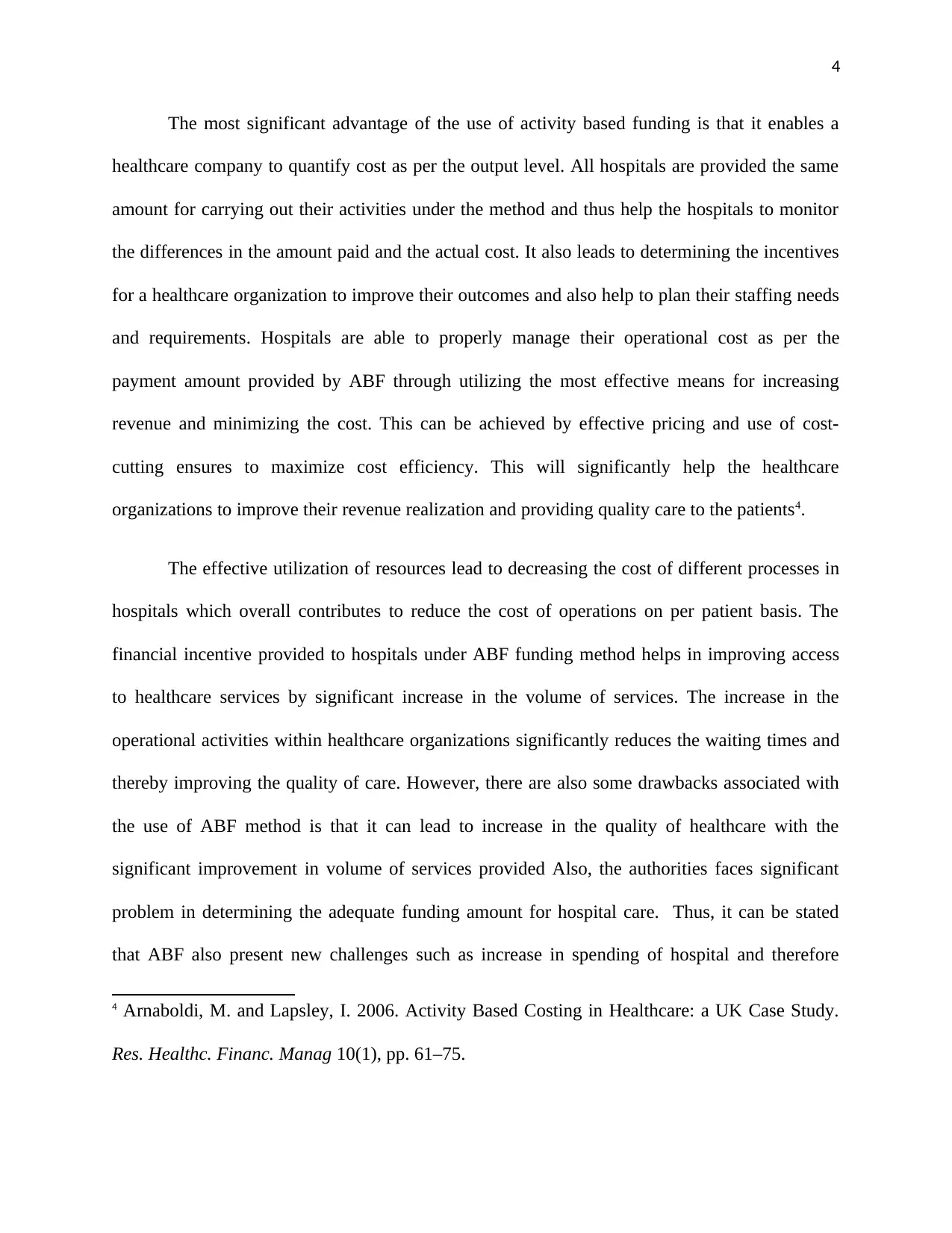
4
The most significant advantage of the use of activity based funding is that it enables a
healthcare company to quantify cost as per the output level. All hospitals are provided the same
amount for carrying out their activities under the method and thus help the hospitals to monitor
the differences in the amount paid and the actual cost. It also leads to determining the incentives
for a healthcare organization to improve their outcomes and also help to plan their staffing needs
and requirements. Hospitals are able to properly manage their operational cost as per the
payment amount provided by ABF through utilizing the most effective means for increasing
revenue and minimizing the cost. This can be achieved by effective pricing and use of cost-
cutting ensures to maximize cost efficiency. This will significantly help the healthcare
organizations to improve their revenue realization and providing quality care to the patients4.
The effective utilization of resources lead to decreasing the cost of different processes in
hospitals which overall contributes to reduce the cost of operations on per patient basis. The
financial incentive provided to hospitals under ABF funding method helps in improving access
to healthcare services by significant increase in the volume of services. The increase in the
operational activities within healthcare organizations significantly reduces the waiting times and
thereby improving the quality of care. However, there are also some drawbacks associated with
the use of ABF method is that it can lead to increase in the quality of healthcare with the
significant improvement in volume of services provided Also, the authorities faces significant
problem in determining the adequate funding amount for hospital care. Thus, it can be stated
that ABF also present new challenges such as increase in spending of hospital and therefore
4 Arnaboldi, M. and Lapsley, I. 2006. Activity Based Costing in Healthcare: a UK Case Study.
Res. Healthc. Financ. Manag 10(1), pp. 61–75.
The most significant advantage of the use of activity based funding is that it enables a
healthcare company to quantify cost as per the output level. All hospitals are provided the same
amount for carrying out their activities under the method and thus help the hospitals to monitor
the differences in the amount paid and the actual cost. It also leads to determining the incentives
for a healthcare organization to improve their outcomes and also help to plan their staffing needs
and requirements. Hospitals are able to properly manage their operational cost as per the
payment amount provided by ABF through utilizing the most effective means for increasing
revenue and minimizing the cost. This can be achieved by effective pricing and use of cost-
cutting ensures to maximize cost efficiency. This will significantly help the healthcare
organizations to improve their revenue realization and providing quality care to the patients4.
The effective utilization of resources lead to decreasing the cost of different processes in
hospitals which overall contributes to reduce the cost of operations on per patient basis. The
financial incentive provided to hospitals under ABF funding method helps in improving access
to healthcare services by significant increase in the volume of services. The increase in the
operational activities within healthcare organizations significantly reduces the waiting times and
thereby improving the quality of care. However, there are also some drawbacks associated with
the use of ABF method is that it can lead to increase in the quality of healthcare with the
significant improvement in volume of services provided Also, the authorities faces significant
problem in determining the adequate funding amount for hospital care. Thus, it can be stated
that ABF also present new challenges such as increase in spending of hospital and therefore
4 Arnaboldi, M. and Lapsley, I. 2006. Activity Based Costing in Healthcare: a UK Case Study.
Res. Healthc. Financ. Manag 10(1), pp. 61–75.
Paraphrase This Document
Need a fresh take? Get an instant paraphrase of this document with our AI Paraphraser
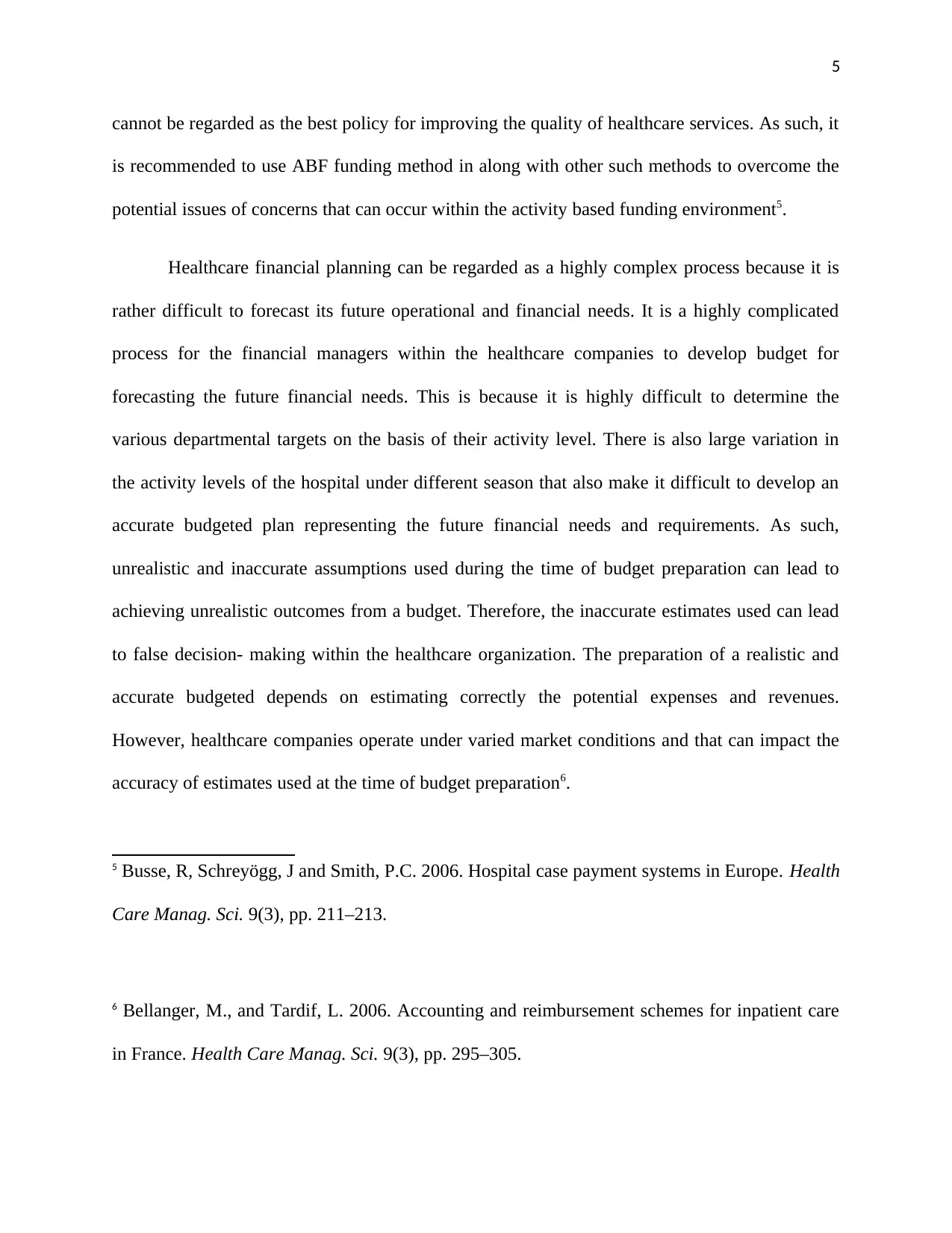
5
cannot be regarded as the best policy for improving the quality of healthcare services. As such, it
is recommended to use ABF funding method in along with other such methods to overcome the
potential issues of concerns that can occur within the activity based funding environment5.
Healthcare financial planning can be regarded as a highly complex process because it is
rather difficult to forecast its future operational and financial needs. It is a highly complicated
process for the financial managers within the healthcare companies to develop budget for
forecasting the future financial needs. This is because it is highly difficult to determine the
various departmental targets on the basis of their activity level. There is also large variation in
the activity levels of the hospital under different season that also make it difficult to develop an
accurate budgeted plan representing the future financial needs and requirements. As such,
unrealistic and inaccurate assumptions used during the time of budget preparation can lead to
achieving unrealistic outcomes from a budget. Therefore, the inaccurate estimates used can lead
to false decision- making within the healthcare organization. The preparation of a realistic and
accurate budgeted depends on estimating correctly the potential expenses and revenues.
However, healthcare companies operate under varied market conditions and that can impact the
accuracy of estimates used at the time of budget preparation6.
5 Busse, R, Schreyögg, J and Smith, P.C. 2006. Hospital case payment systems in Europe. Health
Care Manag. Sci. 9(3), pp. 211–213.
6 Bellanger, M., and Tardif, L. 2006. Accounting and reimbursement schemes for inpatient care
in France. Health Care Manag. Sci. 9(3), pp. 295–305.
cannot be regarded as the best policy for improving the quality of healthcare services. As such, it
is recommended to use ABF funding method in along with other such methods to overcome the
potential issues of concerns that can occur within the activity based funding environment5.
Healthcare financial planning can be regarded as a highly complex process because it is
rather difficult to forecast its future operational and financial needs. It is a highly complicated
process for the financial managers within the healthcare companies to develop budget for
forecasting the future financial needs. This is because it is highly difficult to determine the
various departmental targets on the basis of their activity level. There is also large variation in
the activity levels of the hospital under different season that also make it difficult to develop an
accurate budgeted plan representing the future financial needs and requirements. As such,
unrealistic and inaccurate assumptions used during the time of budget preparation can lead to
achieving unrealistic outcomes from a budget. Therefore, the inaccurate estimates used can lead
to false decision- making within the healthcare organization. The preparation of a realistic and
accurate budgeted depends on estimating correctly the potential expenses and revenues.
However, healthcare companies operate under varied market conditions and that can impact the
accuracy of estimates used at the time of budget preparation6.
5 Busse, R, Schreyögg, J and Smith, P.C. 2006. Hospital case payment systems in Europe. Health
Care Manag. Sci. 9(3), pp. 211–213.
6 Bellanger, M., and Tardif, L. 2006. Accounting and reimbursement schemes for inpatient care
in France. Health Care Manag. Sci. 9(3), pp. 295–305.
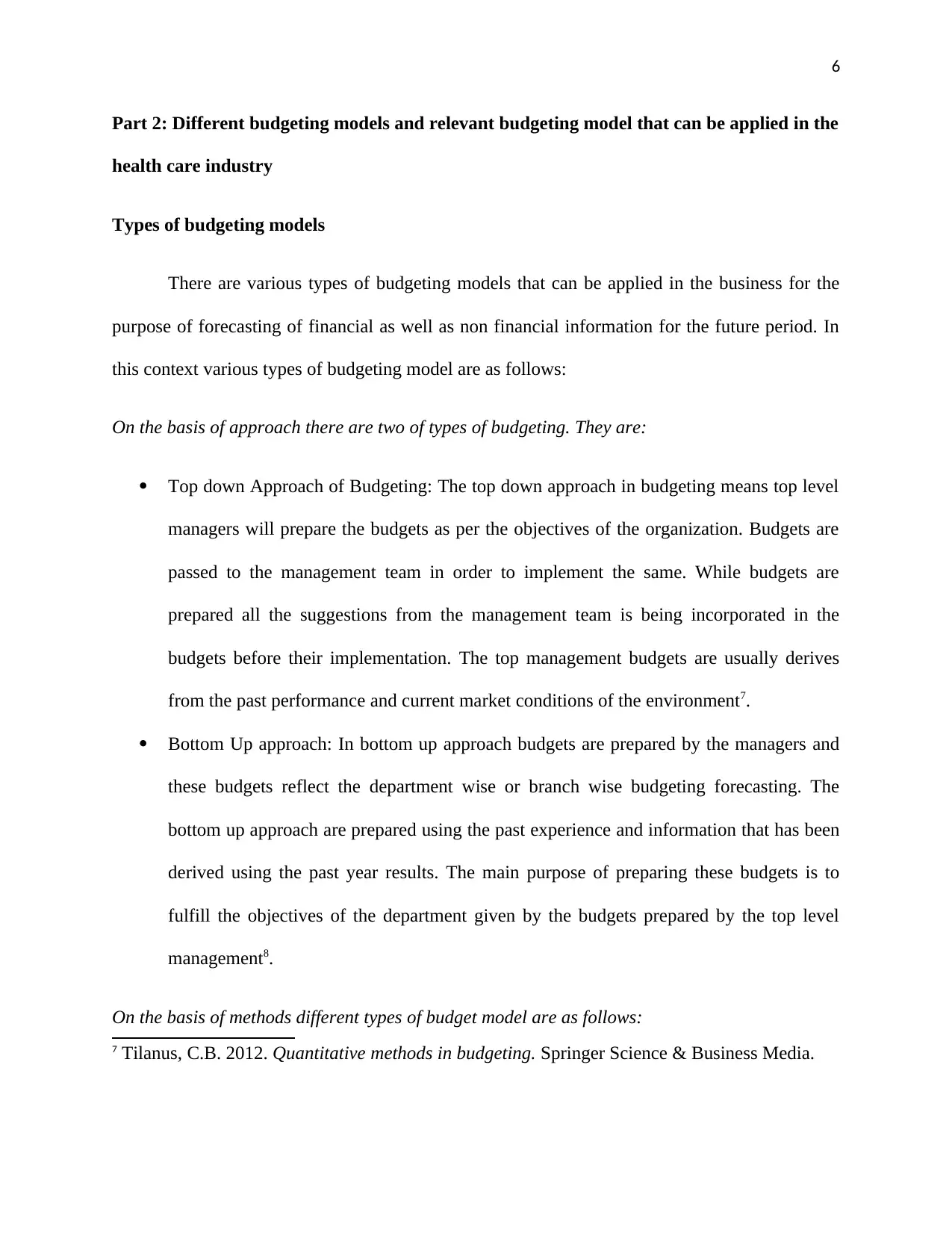
6
Part 2: Different budgeting models and relevant budgeting model that can be applied in the
health care industry
Types of budgeting models
There are various types of budgeting models that can be applied in the business for the
purpose of forecasting of financial as well as non financial information for the future period. In
this context various types of budgeting model are as follows:
On the basis of approach there are two of types of budgeting. They are:
Top down Approach of Budgeting: The top down approach in budgeting means top level
managers will prepare the budgets as per the objectives of the organization. Budgets are
passed to the management team in order to implement the same. While budgets are
prepared all the suggestions from the management team is being incorporated in the
budgets before their implementation. The top management budgets are usually derives
from the past performance and current market conditions of the environment7.
Bottom Up approach: In bottom up approach budgets are prepared by the managers and
these budgets reflect the department wise or branch wise budgeting forecasting. The
bottom up approach are prepared using the past experience and information that has been
derived using the past year results. The main purpose of preparing these budgets is to
fulfill the objectives of the department given by the budgets prepared by the top level
management8.
On the basis of methods different types of budget model are as follows:
7 Tilanus, C.B. 2012. Quantitative methods in budgeting. Springer Science & Business Media.
Part 2: Different budgeting models and relevant budgeting model that can be applied in the
health care industry
Types of budgeting models
There are various types of budgeting models that can be applied in the business for the
purpose of forecasting of financial as well as non financial information for the future period. In
this context various types of budgeting model are as follows:
On the basis of approach there are two of types of budgeting. They are:
Top down Approach of Budgeting: The top down approach in budgeting means top level
managers will prepare the budgets as per the objectives of the organization. Budgets are
passed to the management team in order to implement the same. While budgets are
prepared all the suggestions from the management team is being incorporated in the
budgets before their implementation. The top management budgets are usually derives
from the past performance and current market conditions of the environment7.
Bottom Up approach: In bottom up approach budgets are prepared by the managers and
these budgets reflect the department wise or branch wise budgeting forecasting. The
bottom up approach are prepared using the past experience and information that has been
derived using the past year results. The main purpose of preparing these budgets is to
fulfill the objectives of the department given by the budgets prepared by the top level
management8.
On the basis of methods different types of budget model are as follows:
7 Tilanus, C.B. 2012. Quantitative methods in budgeting. Springer Science & Business Media.
⊘ This is a preview!⊘
Do you want full access?
Subscribe today to unlock all pages.

Trusted by 1+ million students worldwide
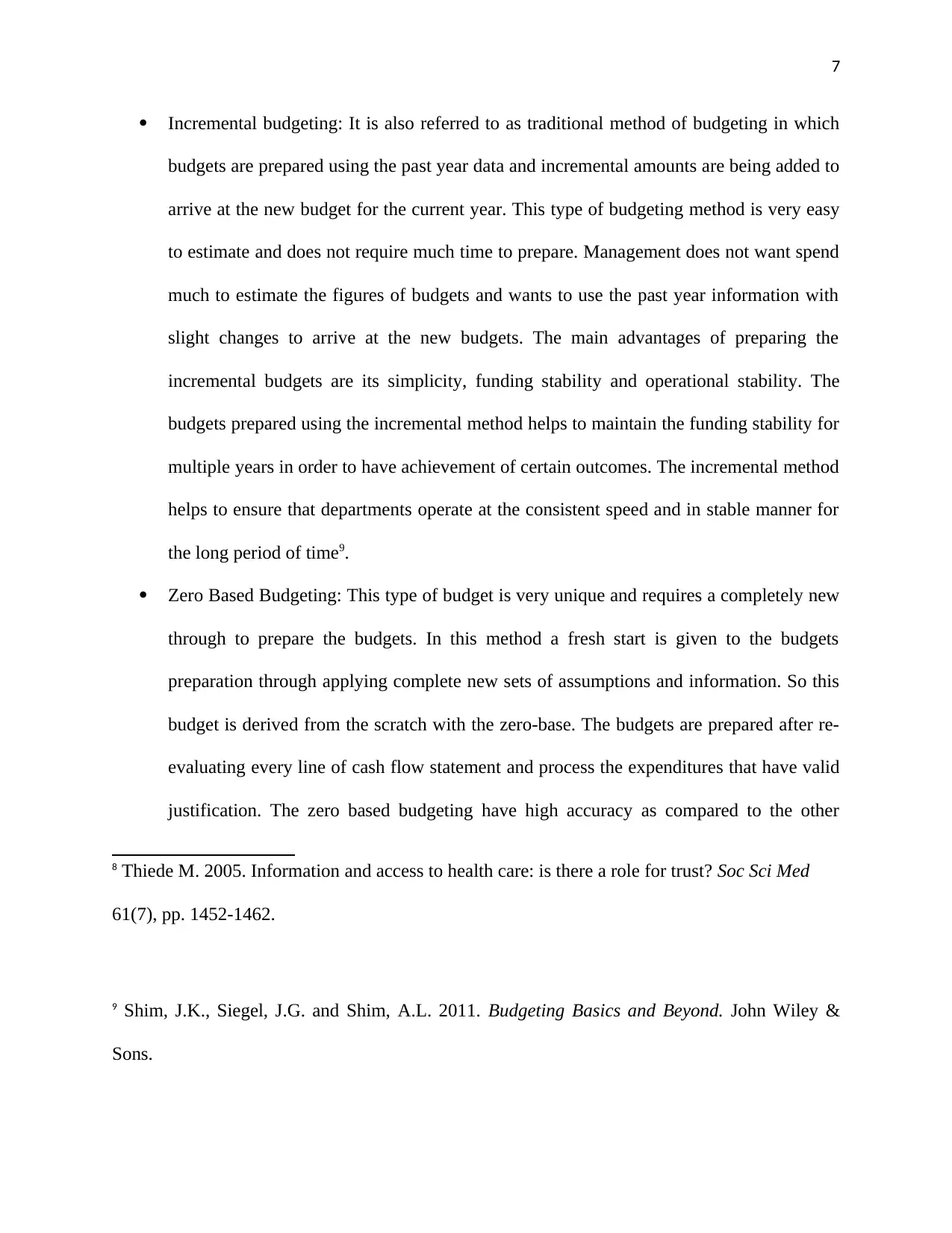
7
Incremental budgeting: It is also referred to as traditional method of budgeting in which
budgets are prepared using the past year data and incremental amounts are being added to
arrive at the new budget for the current year. This type of budgeting method is very easy
to estimate and does not require much time to prepare. Management does not want spend
much to estimate the figures of budgets and wants to use the past year information with
slight changes to arrive at the new budgets. The main advantages of preparing the
incremental budgets are its simplicity, funding stability and operational stability. The
budgets prepared using the incremental method helps to maintain the funding stability for
multiple years in order to have achievement of certain outcomes. The incremental method
helps to ensure that departments operate at the consistent speed and in stable manner for
the long period of time9.
Zero Based Budgeting: This type of budget is very unique and requires a completely new
through to prepare the budgets. In this method a fresh start is given to the budgets
preparation through applying complete new sets of assumptions and information. So this
budget is derived from the scratch with the zero-base. The budgets are prepared after re-
evaluating every line of cash flow statement and process the expenditures that have valid
justification. The zero based budgeting have high accuracy as compared to the other
8 Thiede M. 2005. Information and access to health care: is there a role for trust? Soc Sci Med
61(7), pp. 1452-1462.
9 Shim, J.K., Siegel, J.G. and Shim, A.L. 2011. Budgeting Basics and Beyond. John Wiley &
Sons.
Incremental budgeting: It is also referred to as traditional method of budgeting in which
budgets are prepared using the past year data and incremental amounts are being added to
arrive at the new budget for the current year. This type of budgeting method is very easy
to estimate and does not require much time to prepare. Management does not want spend
much to estimate the figures of budgets and wants to use the past year information with
slight changes to arrive at the new budgets. The main advantages of preparing the
incremental budgets are its simplicity, funding stability and operational stability. The
budgets prepared using the incremental method helps to maintain the funding stability for
multiple years in order to have achievement of certain outcomes. The incremental method
helps to ensure that departments operate at the consistent speed and in stable manner for
the long period of time9.
Zero Based Budgeting: This type of budget is very unique and requires a completely new
through to prepare the budgets. In this method a fresh start is given to the budgets
preparation through applying complete new sets of assumptions and information. So this
budget is derived from the scratch with the zero-base. The budgets are prepared after re-
evaluating every line of cash flow statement and process the expenditures that have valid
justification. The zero based budgeting have high accuracy as compared to the other
8 Thiede M. 2005. Information and access to health care: is there a role for trust? Soc Sci Med
61(7), pp. 1452-1462.
9 Shim, J.K., Siegel, J.G. and Shim, A.L. 2011. Budgeting Basics and Beyond. John Wiley &
Sons.
Paraphrase This Document
Need a fresh take? Get an instant paraphrase of this document with our AI Paraphraser
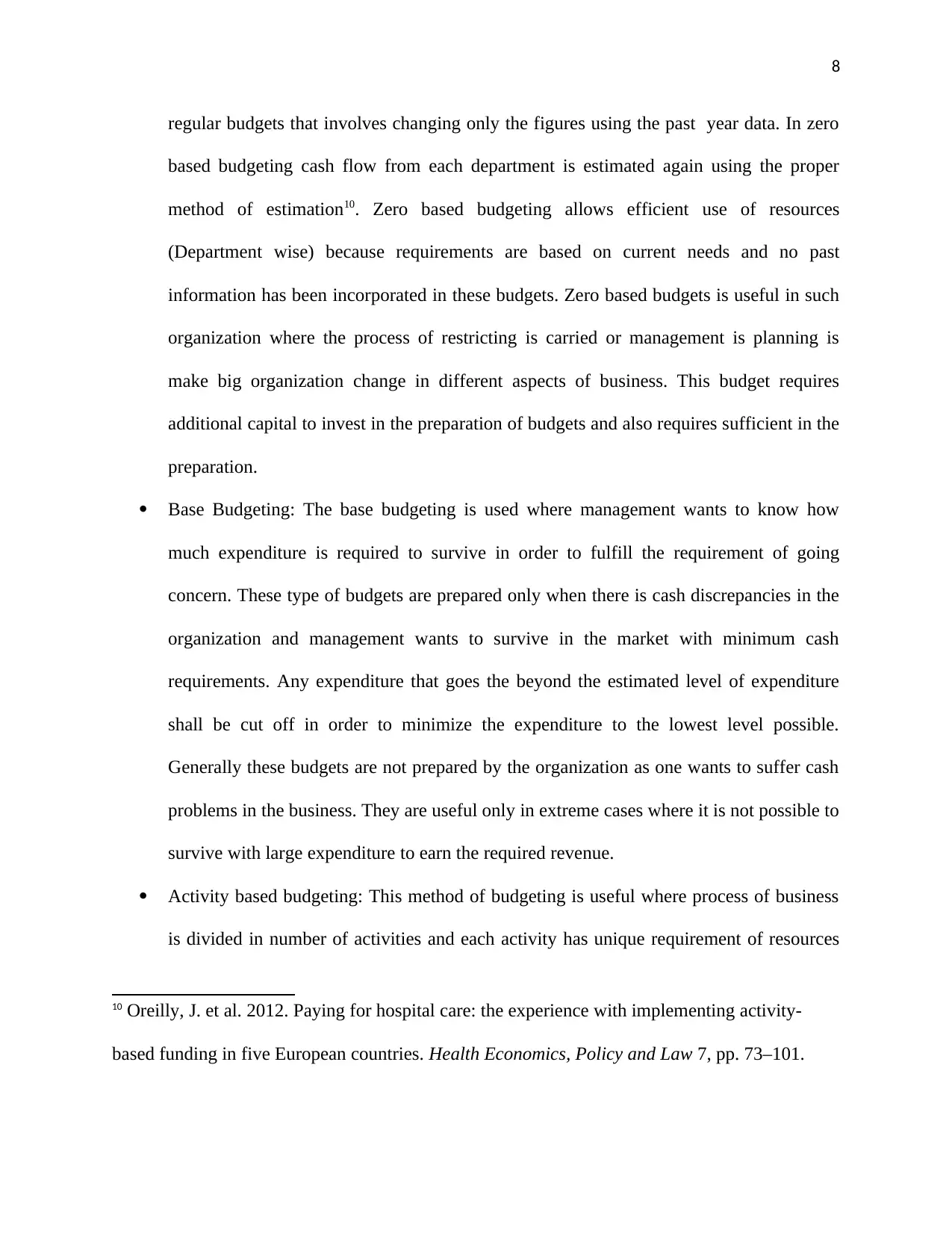
8
regular budgets that involves changing only the figures using the past year data. In zero
based budgeting cash flow from each department is estimated again using the proper
method of estimation10. Zero based budgeting allows efficient use of resources
(Department wise) because requirements are based on current needs and no past
information has been incorporated in these budgets. Zero based budgets is useful in such
organization where the process of restricting is carried or management is planning is
make big organization change in different aspects of business. This budget requires
additional capital to invest in the preparation of budgets and also requires sufficient in the
preparation.
Base Budgeting: The base budgeting is used where management wants to know how
much expenditure is required to survive in order to fulfill the requirement of going
concern. These type of budgets are prepared only when there is cash discrepancies in the
organization and management wants to survive in the market with minimum cash
requirements. Any expenditure that goes the beyond the estimated level of expenditure
shall be cut off in order to minimize the expenditure to the lowest level possible.
Generally these budgets are not prepared by the organization as one wants to suffer cash
problems in the business. They are useful only in extreme cases where it is not possible to
survive with large expenditure to earn the required revenue.
Activity based budgeting: This method of budgeting is useful where process of business
is divided in number of activities and each activity has unique requirement of resources
10 Oreilly, J. et al. 2012. Paying for hospital care: the experience with implementing activity-
based funding in five European countries. Health Economics, Policy and Law 7, pp. 73–101.
regular budgets that involves changing only the figures using the past year data. In zero
based budgeting cash flow from each department is estimated again using the proper
method of estimation10. Zero based budgeting allows efficient use of resources
(Department wise) because requirements are based on current needs and no past
information has been incorporated in these budgets. Zero based budgets is useful in such
organization where the process of restricting is carried or management is planning is
make big organization change in different aspects of business. This budget requires
additional capital to invest in the preparation of budgets and also requires sufficient in the
preparation.
Base Budgeting: The base budgeting is used where management wants to know how
much expenditure is required to survive in order to fulfill the requirement of going
concern. These type of budgets are prepared only when there is cash discrepancies in the
organization and management wants to survive in the market with minimum cash
requirements. Any expenditure that goes the beyond the estimated level of expenditure
shall be cut off in order to minimize the expenditure to the lowest level possible.
Generally these budgets are not prepared by the organization as one wants to suffer cash
problems in the business. They are useful only in extreme cases where it is not possible to
survive with large expenditure to earn the required revenue.
Activity based budgeting: This method of budgeting is useful where process of business
is divided in number of activities and each activity has unique requirement of resources
10 Oreilly, J. et al. 2012. Paying for hospital care: the experience with implementing activity-
based funding in five European countries. Health Economics, Policy and Law 7, pp. 73–101.
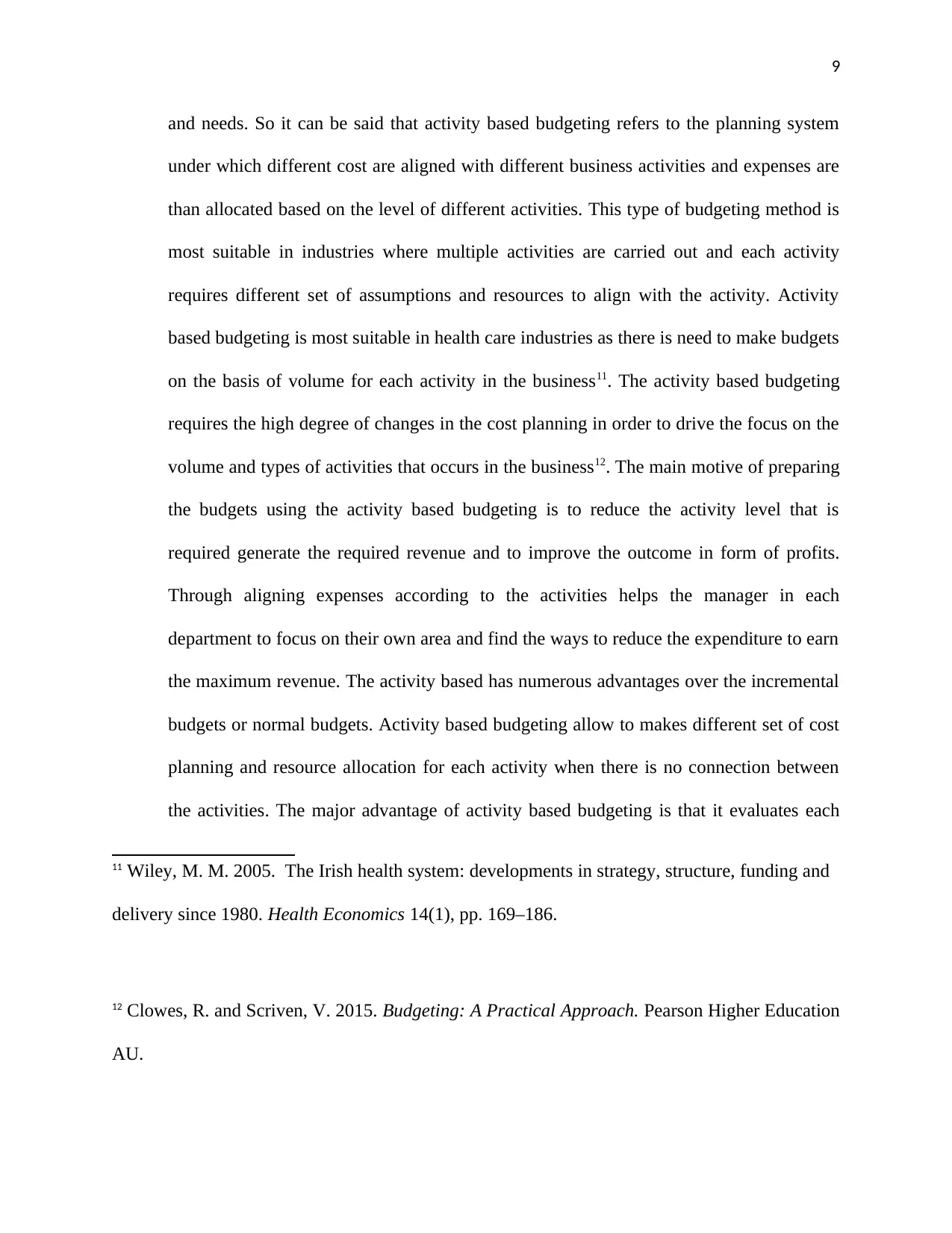
9
and needs. So it can be said that activity based budgeting refers to the planning system
under which different cost are aligned with different business activities and expenses are
than allocated based on the level of different activities. This type of budgeting method is
most suitable in industries where multiple activities are carried out and each activity
requires different set of assumptions and resources to align with the activity. Activity
based budgeting is most suitable in health care industries as there is need to make budgets
on the basis of volume for each activity in the business11. The activity based budgeting
requires the high degree of changes in the cost planning in order to drive the focus on the
volume and types of activities that occurs in the business12. The main motive of preparing
the budgets using the activity based budgeting is to reduce the activity level that is
required generate the required revenue and to improve the outcome in form of profits.
Through aligning expenses according to the activities helps the manager in each
department to focus on their own area and find the ways to reduce the expenditure to earn
the maximum revenue. The activity based has numerous advantages over the incremental
budgets or normal budgets. Activity based budgeting allow to makes different set of cost
planning and resource allocation for each activity when there is no connection between
the activities. The major advantage of activity based budgeting is that it evaluates each
11 Wiley, M. M. 2005. The Irish health system: developments in strategy, structure, funding and
delivery since 1980. Health Economics 14(1), pp. 169–186.
12 Clowes, R. and Scriven, V. 2015. Budgeting: A Practical Approach. Pearson Higher Education
AU.
and needs. So it can be said that activity based budgeting refers to the planning system
under which different cost are aligned with different business activities and expenses are
than allocated based on the level of different activities. This type of budgeting method is
most suitable in industries where multiple activities are carried out and each activity
requires different set of assumptions and resources to align with the activity. Activity
based budgeting is most suitable in health care industries as there is need to make budgets
on the basis of volume for each activity in the business11. The activity based budgeting
requires the high degree of changes in the cost planning in order to drive the focus on the
volume and types of activities that occurs in the business12. The main motive of preparing
the budgets using the activity based budgeting is to reduce the activity level that is
required generate the required revenue and to improve the outcome in form of profits.
Through aligning expenses according to the activities helps the manager in each
department to focus on their own area and find the ways to reduce the expenditure to earn
the maximum revenue. The activity based has numerous advantages over the incremental
budgets or normal budgets. Activity based budgeting allow to makes different set of cost
planning and resource allocation for each activity when there is no connection between
the activities. The major advantage of activity based budgeting is that it evaluates each
11 Wiley, M. M. 2005. The Irish health system: developments in strategy, structure, funding and
delivery since 1980. Health Economics 14(1), pp. 169–186.
12 Clowes, R. and Scriven, V. 2015. Budgeting: A Practical Approach. Pearson Higher Education
AU.
⊘ This is a preview!⊘
Do you want full access?
Subscribe today to unlock all pages.

Trusted by 1+ million students worldwide
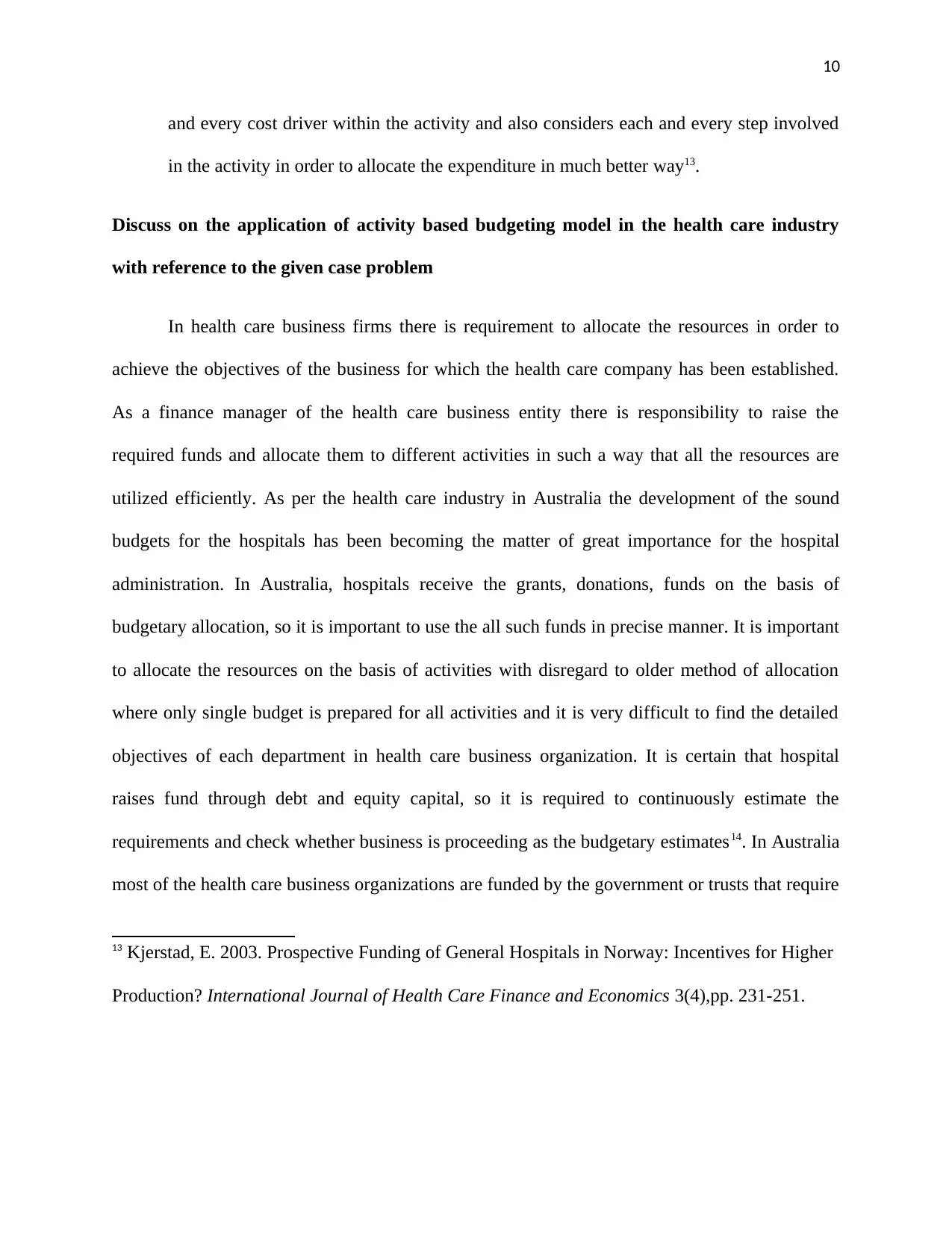
10
and every cost driver within the activity and also considers each and every step involved
in the activity in order to allocate the expenditure in much better way13.
Discuss on the application of activity based budgeting model in the health care industry
with reference to the given case problem
In health care business firms there is requirement to allocate the resources in order to
achieve the objectives of the business for which the health care company has been established.
As a finance manager of the health care business entity there is responsibility to raise the
required funds and allocate them to different activities in such a way that all the resources are
utilized efficiently. As per the health care industry in Australia the development of the sound
budgets for the hospitals has been becoming the matter of great importance for the hospital
administration. In Australia, hospitals receive the grants, donations, funds on the basis of
budgetary allocation, so it is important to use the all such funds in precise manner. It is important
to allocate the resources on the basis of activities with disregard to older method of allocation
where only single budget is prepared for all activities and it is very difficult to find the detailed
objectives of each department in health care business organization. It is certain that hospital
raises fund through debt and equity capital, so it is required to continuously estimate the
requirements and check whether business is proceeding as the budgetary estimates14. In Australia
most of the health care business organizations are funded by the government or trusts that require
13 Kjerstad, E. 2003. Prospective Funding of General Hospitals in Norway: Incentives for Higher
Production? International Journal of Health Care Finance and Economics 3(4),pp. 231-251.
and every cost driver within the activity and also considers each and every step involved
in the activity in order to allocate the expenditure in much better way13.
Discuss on the application of activity based budgeting model in the health care industry
with reference to the given case problem
In health care business firms there is requirement to allocate the resources in order to
achieve the objectives of the business for which the health care company has been established.
As a finance manager of the health care business entity there is responsibility to raise the
required funds and allocate them to different activities in such a way that all the resources are
utilized efficiently. As per the health care industry in Australia the development of the sound
budgets for the hospitals has been becoming the matter of great importance for the hospital
administration. In Australia, hospitals receive the grants, donations, funds on the basis of
budgetary allocation, so it is important to use the all such funds in precise manner. It is important
to allocate the resources on the basis of activities with disregard to older method of allocation
where only single budget is prepared for all activities and it is very difficult to find the detailed
objectives of each department in health care business organization. It is certain that hospital
raises fund through debt and equity capital, so it is required to continuously estimate the
requirements and check whether business is proceeding as the budgetary estimates14. In Australia
most of the health care business organizations are funded by the government or trusts that require
13 Kjerstad, E. 2003. Prospective Funding of General Hospitals in Norway: Incentives for Higher
Production? International Journal of Health Care Finance and Economics 3(4),pp. 231-251.
Paraphrase This Document
Need a fresh take? Get an instant paraphrase of this document with our AI Paraphraser
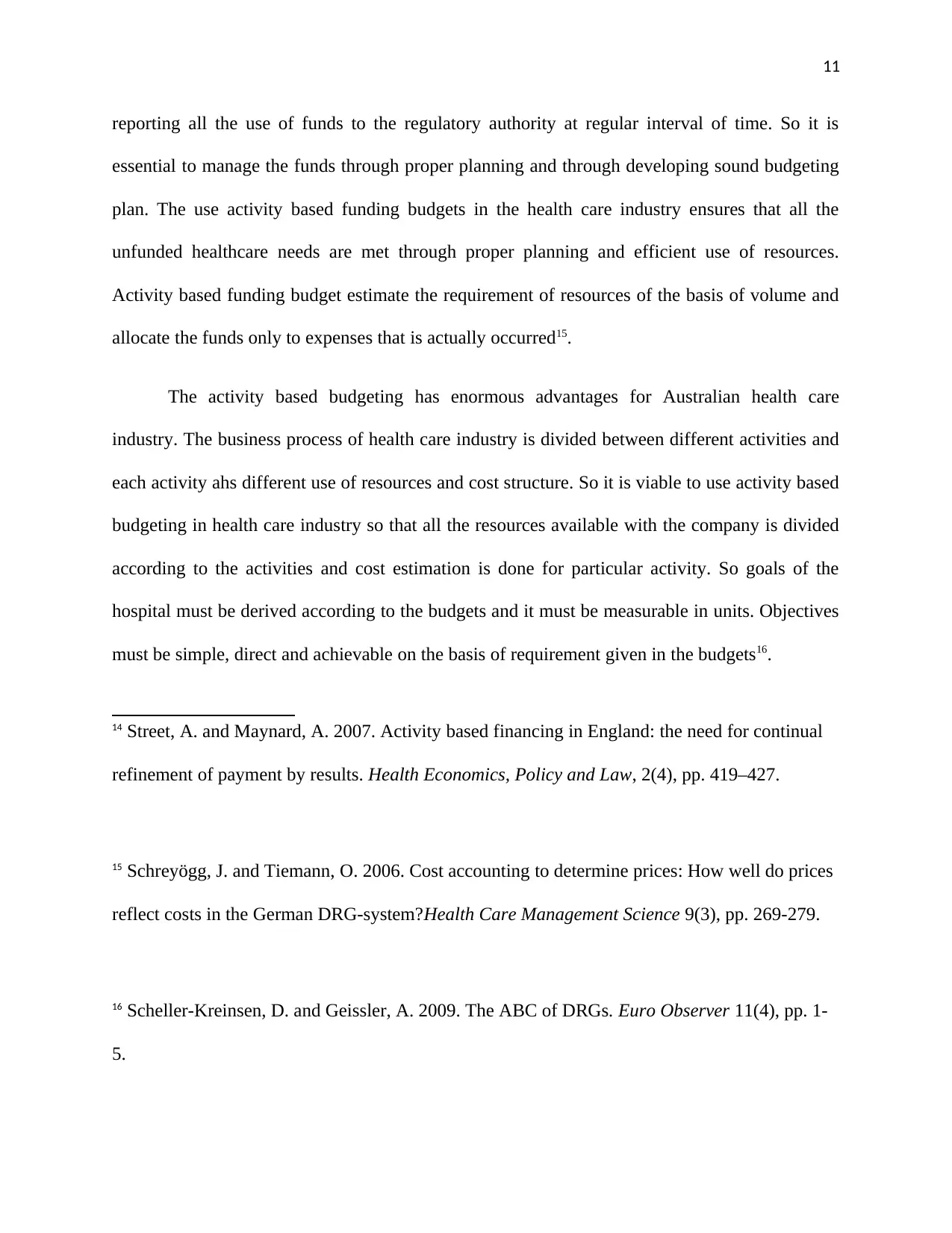
11
reporting all the use of funds to the regulatory authority at regular interval of time. So it is
essential to manage the funds through proper planning and through developing sound budgeting
plan. The use activity based funding budgets in the health care industry ensures that all the
unfunded healthcare needs are met through proper planning and efficient use of resources.
Activity based funding budget estimate the requirement of resources of the basis of volume and
allocate the funds only to expenses that is actually occurred15.
The activity based budgeting has enormous advantages for Australian health care
industry. The business process of health care industry is divided between different activities and
each activity ahs different use of resources and cost structure. So it is viable to use activity based
budgeting in health care industry so that all the resources available with the company is divided
according to the activities and cost estimation is done for particular activity. So goals of the
hospital must be derived according to the budgets and it must be measurable in units. Objectives
must be simple, direct and achievable on the basis of requirement given in the budgets16.
14 Street, A. and Maynard, A. 2007. Activity based financing in England: the need for continual
refinement of payment by results. Health Economics, Policy and Law, 2(4), pp. 419–427.
15 Schreyögg, J. and Tiemann, O. 2006. Cost accounting to determine prices: How well do prices
reflect costs in the German DRG-system?Health Care Management Science 9(3), pp. 269-279.
16 Scheller-Kreinsen, D. and Geissler, A. 2009. The ABC of DRGs. Euro Observer 11(4), pp. 1-
5.
reporting all the use of funds to the regulatory authority at regular interval of time. So it is
essential to manage the funds through proper planning and through developing sound budgeting
plan. The use activity based funding budgets in the health care industry ensures that all the
unfunded healthcare needs are met through proper planning and efficient use of resources.
Activity based funding budget estimate the requirement of resources of the basis of volume and
allocate the funds only to expenses that is actually occurred15.
The activity based budgeting has enormous advantages for Australian health care
industry. The business process of health care industry is divided between different activities and
each activity ahs different use of resources and cost structure. So it is viable to use activity based
budgeting in health care industry so that all the resources available with the company is divided
according to the activities and cost estimation is done for particular activity. So goals of the
hospital must be derived according to the budgets and it must be measurable in units. Objectives
must be simple, direct and achievable on the basis of requirement given in the budgets16.
14 Street, A. and Maynard, A. 2007. Activity based financing in England: the need for continual
refinement of payment by results. Health Economics, Policy and Law, 2(4), pp. 419–427.
15 Schreyögg, J. and Tiemann, O. 2006. Cost accounting to determine prices: How well do prices
reflect costs in the German DRG-system?Health Care Management Science 9(3), pp. 269-279.
16 Scheller-Kreinsen, D. and Geissler, A. 2009. The ABC of DRGs. Euro Observer 11(4), pp. 1-
5.
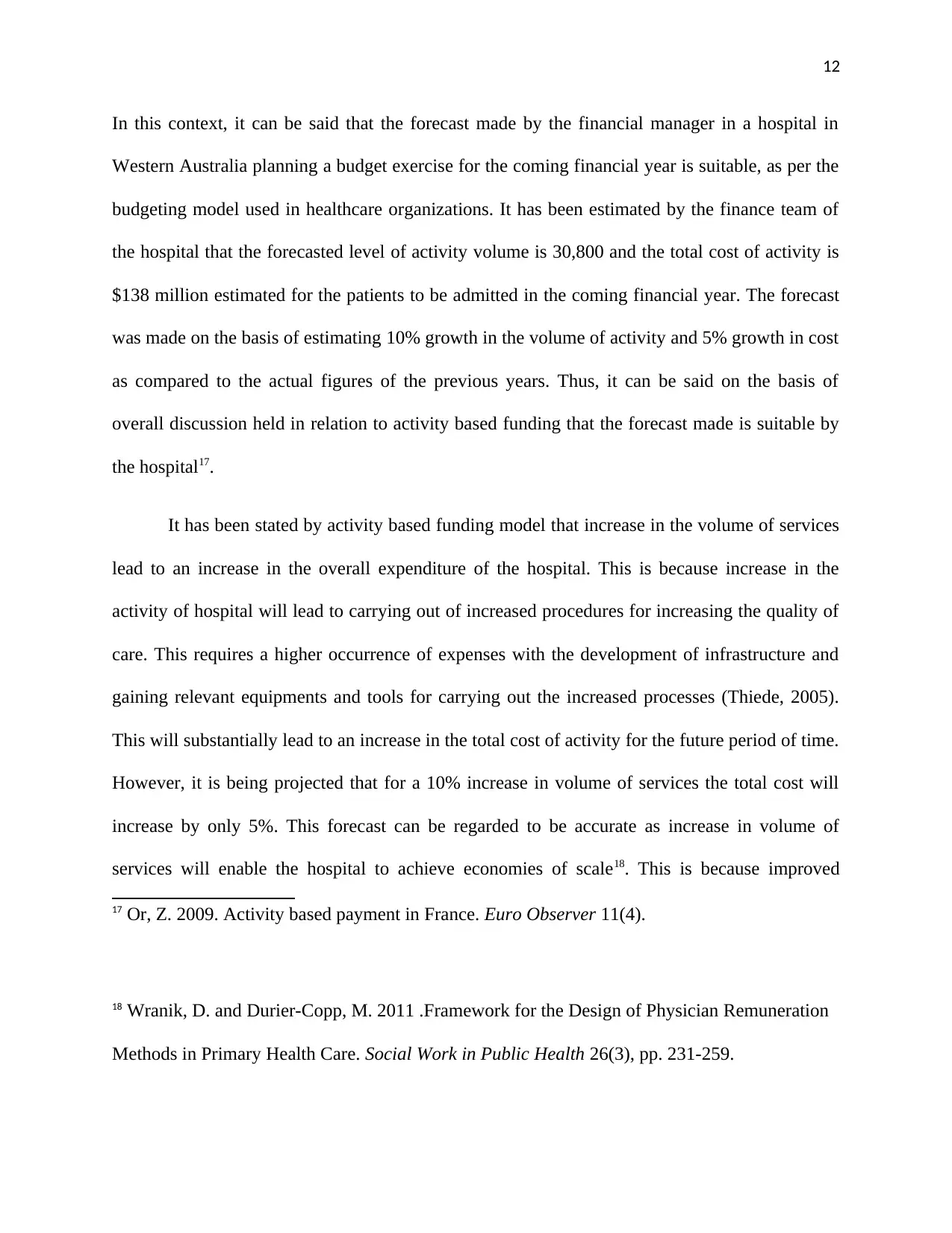
12
In this context, it can be said that the forecast made by the financial manager in a hospital in
Western Australia planning a budget exercise for the coming financial year is suitable, as per the
budgeting model used in healthcare organizations. It has been estimated by the finance team of
the hospital that the forecasted level of activity volume is 30,800 and the total cost of activity is
$138 million estimated for the patients to be admitted in the coming financial year. The forecast
was made on the basis of estimating 10% growth in the volume of activity and 5% growth in cost
as compared to the actual figures of the previous years. Thus, it can be said on the basis of
overall discussion held in relation to activity based funding that the forecast made is suitable by
the hospital17.
It has been stated by activity based funding model that increase in the volume of services
lead to an increase in the overall expenditure of the hospital. This is because increase in the
activity of hospital will lead to carrying out of increased procedures for increasing the quality of
care. This requires a higher occurrence of expenses with the development of infrastructure and
gaining relevant equipments and tools for carrying out the increased processes (Thiede, 2005).
This will substantially lead to an increase in the total cost of activity for the future period of time.
However, it is being projected that for a 10% increase in volume of services the total cost will
increase by only 5%. This forecast can be regarded to be accurate as increase in volume of
services will enable the hospital to achieve economies of scale18. This is because improved
17 Or, Z. 2009. Activity based payment in France. Euro Observer 11(4).
18 Wranik, D. and Durier-Copp, M. 2011 .Framework for the Design of Physician Remuneration
Methods in Primary Health Care. Social Work in Public Health 26(3), pp. 231-259.
In this context, it can be said that the forecast made by the financial manager in a hospital in
Western Australia planning a budget exercise for the coming financial year is suitable, as per the
budgeting model used in healthcare organizations. It has been estimated by the finance team of
the hospital that the forecasted level of activity volume is 30,800 and the total cost of activity is
$138 million estimated for the patients to be admitted in the coming financial year. The forecast
was made on the basis of estimating 10% growth in the volume of activity and 5% growth in cost
as compared to the actual figures of the previous years. Thus, it can be said on the basis of
overall discussion held in relation to activity based funding that the forecast made is suitable by
the hospital17.
It has been stated by activity based funding model that increase in the volume of services
lead to an increase in the overall expenditure of the hospital. This is because increase in the
activity of hospital will lead to carrying out of increased procedures for increasing the quality of
care. This requires a higher occurrence of expenses with the development of infrastructure and
gaining relevant equipments and tools for carrying out the increased processes (Thiede, 2005).
This will substantially lead to an increase in the total cost of activity for the future period of time.
However, it is being projected that for a 10% increase in volume of services the total cost will
increase by only 5%. This forecast can be regarded to be accurate as increase in volume of
services will enable the hospital to achieve economies of scale18. This is because improved
17 Or, Z. 2009. Activity based payment in France. Euro Observer 11(4).
18 Wranik, D. and Durier-Copp, M. 2011 .Framework for the Design of Physician Remuneration
Methods in Primary Health Care. Social Work in Public Health 26(3), pp. 231-259.
⊘ This is a preview!⊘
Do you want full access?
Subscribe today to unlock all pages.

Trusted by 1+ million students worldwide
1 out of 15
Related Documents
Your All-in-One AI-Powered Toolkit for Academic Success.
+13062052269
info@desklib.com
Available 24*7 on WhatsApp / Email
![[object Object]](/_next/static/media/star-bottom.7253800d.svg)
Unlock your academic potential
Copyright © 2020–2025 A2Z Services. All Rights Reserved. Developed and managed by ZUCOL.





